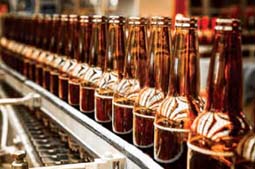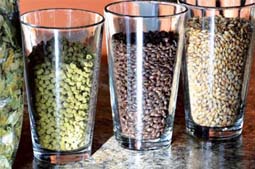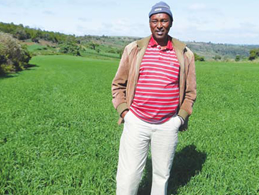Barley Farming is Changing Lives
 To many, just a mention of the word Mau Narok conjures an image of lush green area in Nakuru County that is best known as Kenya’s food basket.
To many, just a mention of the word Mau Narok conjures an image of lush green area in Nakuru County that is best known as Kenya’s food basket.
The expansive fertile land is considered as Kenya’s granary. Countries such as Uganda import carrots from the region.
Apart from carrots, the area is known for potato, cabbage, maize farming besides sheep rearing.
Barley Farming
Unknown to many, the hills of Mau Narok is also a fertile ground of the lucrative barley farming that has changed the lives of many locals.
Beer makers East Africa Breweries Limited (EABL) has entered into contract farming with farmers in the region and this has improved production.
The aged have been growing barley for nearly 50 years. They started growing the crop in early 1970s at a time when maize and wheat were the preferred cash crops.
To grow barley, one must prepare the land well by killing weeds using herbicides followed by ploughing and harrowing.
Fertiliser Ratio
One acre needs some 30-40kg of seeds depending on variety. The recommended fertiliser ratio is 175kg per acre.
Spacing between the rows is 20cm while from one plant to another is 10cm. Top-dressing is done at 50kg per acre depending. Fungicides are applied 35 days after planting, while foliar feed is applied before flowering.
And as the profit margin increased with every harvest, most farmers increased their acreage and demand for the barley by EABL also increased.
“When I reflect on how I started the venture, I have no regrets. My farming has expanded and those farmers who were reluctant to grow barley have joined me,” says Mr. Kilesi.
Barley growing has transformed their life, making them lay a strong foundation for their children.
“I have constructed a permanent house and all my children have acquired neccesary education, something I never dreamt of achieving,” said one farmer.
He says the credit facility offered by the brewer has enabled him get seeds and fertiliser.
“The loan repayment is stress free as it is deducted from my payment and what is left after deductions is enough to sustain my family,” he says.
Hundreds of farmers are now supplying the company with high quality grain for the brewing of beer.
“As a company, our commitment is to source over 80 per cent of raw materials from local farmers as one way of improving production and empowering them to eradicate poverty,” said East Africa Malting Limited (EAML).
EABL pays barley farmers over Sh1 billion yearly. According to statistics, about 60 per cent of barley processed by the company come from Mau Narok region. The company processes more than 40,000 tonnes of barley from the region.
But what is the secret of rapid production in recent years?
New Varieties: This output can be attributed to the introduction of new grain which have led to the production of higher yields and greater resistance to water logging. The new varieties of barely are a game changer. Since I started planting aliciana variety, my yield has increased to 2,200kg per acre,” says one farmer. The grace variety yields about 1,500 kg per acre.
These high yielding varieties are as a result of heavy investment in research by EABL, this has translated into more money into the pockets of farmers and good quality malting material for the company and high quality beer for our consumers. EABL commitment to continue improving its agronomical systems. Their ultimate goal is to create sustainable relationship that is beneficial to all along the value chain.
Seamless Supply: One of the longest barley farmers in the region, Mr David Kilesi who started farming in 1972, said the supply of quality seeds and availability of extension officers has turned around farming in the region. “The secret of success is seamless supply of quality seeds, and the extension officers who advise us on best farming practices and the purchase of our produce at good prices by KBL,” said Mr Kilesi who is also the chairman of the Barley Gowers Association of Kenya.
 While many young people are not interested in farming, in Mau Narok, the farmers have encouraged their children to follow in their footsteps.
While many young people are not interested in farming, in Mau Narok, the farmers have encouraged their children to follow in their footsteps.
“The extension officers have also trained our children on barley farming and are now planting the cash crop,” said Mr Kilesi.
The annual farmers’ field days have seen about 85 per cent of the farmers in the region to embrace barley farming.
Seed Dressers: Farmers’ field days are critical as farmers learn tips on how to cultivate, seed rates, fertiliser usage, recommended insecticides, fungicides, herbicides to be used on barley and seed dressers.
For one to be contracted, the farm, should be at least 15 acres for the purposes of mechanisation. It should also be within the barley growing zone.
Diseases: However, barley farming has had its share of challenges and top on the list being resistance to pesticides, weeds and erratic weather patterns. Diseases like net blotch, scald, barley yellow dwarf virus and leaf rust are also a problem while pests include Russian wheat aphid.
Switching from barley to wheat is a challenge to brewers
Lodging, which happens when the barley slouches and falls due to excess use of fertiliser or because of heavy rains or winds, presents a challenge to farmers as most of the grain is left uncollected on the ground since the combine harvester cannot pick it.
 The switching from barley to wheat is one of the challenges the East Africa Maltings Ltd (EAML), a subsidiary of East African Breweries Limited, which contracts farmers in the major barley growing areas.
The switching from barley to wheat is one of the challenges the East Africa Maltings Ltd (EAML), a subsidiary of East African Breweries Limited, which contracts farmers in the major barley growing areas.
“When the wheat prices are good, you find farmers shifting to the crop. The good thing with barley is that you do it on contract so that by the time of planting, one already knows the price, says Mr. Kilesi.
Farmers are contracted at the start of the season based on sales projections for the year. After EABL have known how much will be required to make alcohol.
The search for better returns from wheat has not spared even the big farmer. Purko Development Trust Agricultural Estate, a communally owned land in Tipis, Mau Narok, is one of the big farms contracted by EAML. The group has on average 500 acres of its vast 3,600acre-estate under barley and 700 acres under wheat, while the rest is used for pasture.
 The farm gets up to 3 tonnes of barley per acre, but in a bad year of heavy rains and strong wind, yields can halve, the brewer provides them with inputs like seeds, herbicides, fungicides and fertilisers. Due to lodging, earnings in most cases reduce from between Sh45,000 and Sh60,000 per acre to Sh24,000, a reason that makes farmers shift to wheat.
The farm gets up to 3 tonnes of barley per acre, but in a bad year of heavy rains and strong wind, yields can halve, the brewer provides them with inputs like seeds, herbicides, fungicides and fertilisers. Due to lodging, earnings in most cases reduce from between Sh45,000 and Sh60,000 per acre to Sh24,000, a reason that makes farmers shift to wheat.
Barley if well-grown is 1.5 times higher than wheat
An agro-economist at Tegemeo Institute, notes that it is important for farmers to look at the economics of barley and wheat production before making decision.
“Barley takes about four months to grow compared to wheat which takes five months. This short growing period reduces the labour time tied to the farmer, more for barley than with wheat.”
He adds that the production level for barley if well-grown is 1.5 times higher than wheat, with barley having a potential of 30 bags per acre while wheat can go up to 18-20 bags.
“The higher yields lead to more returns given the lucrative market for barley which is grown under contract farming with the EAML. The firm also provides training and inputs to farmers, which motivates its production. Barley prices are offered by the brewer compared to wheat price, which is market-driven.
“Wheat like maize is prone to fluctuating prices due to importation which dampen their prices in the markets. The production areas of Narok, Njoro, South Rift regions and the North Rift are further prone to lethal necrosis diseases. It, therefore, makes sense to grow barley.”
We will Soldier On
The main challenge with barley, is its high cost of insecticides, pesticides, fungicides and the recommended chemicals.
Despite these challenges, many farmers are determined to soldier on continue enjoying the benefits of barley farming.